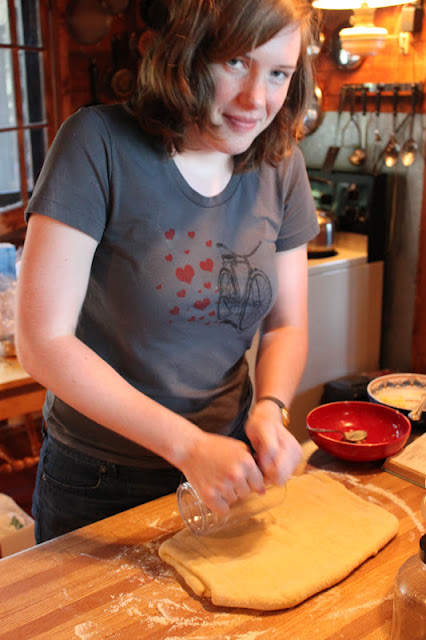Luckily the big challenges seem to be reserved to the new home so far (like major water pipes bursting at 7 at night because the city of Providence is doing construction work on our street). Normally this would be a minor annoyance. But when the past three months have felt like one massive bundle of changes, it turns into a big frustration. Like, crying-worthy (don't worry, I didn't cry over the loss of water pressure....but I thought about it).
Even cooking, my old standby, has been hit with the new house challenge bug. A few days ago I decided to try out an ice cream maker given to us by Josh's grandmother. I'd recently gotten a copy of Jeni's Splendid Ice Creams at Home and was dying to try out at least half of the recipes straight away. What better time to try out the ice cream maker?
 |
| Jeni's t-shirt, Jeni's cookbook, Jeni's ice cream |
Hah. Well. A better time may have been once things settled down and I didn't feel like crying at the drop of a hat. As it turns out, ice cream making is a little trickier than the manual makes it sound.
First, some background: Jeni Britton Bauer founded Jeni's Splendid Ice Creams in Columbus, OH, after years of experimenting with homemade ice cream. Her business has grown to 9 shops in Ohio and 2 in Tennessee, and just last summer I discovered that one of those shops happened to be in my hometown. With flavors like Salty Caramel, Queen City Cayenne (spicy chocolate), and Lemon and Blueberries, it was like a revelation. I went basically every day I was home that summer.
And now there's a cookbook! I ambitiously decided to make her Sweet Corn and Black Raspberry ice cream instead of continuing to unpack in the new apartment (YOU tell me which one sounds like more fun). And I quickly discovered that when you haven't used an ice cream maker with a frozen canister before, that canister has to be frozen for a full 24 hours before you use it. Otherwise your beautiful, creamy mixture scented with corn will refuse to freeze. It will instead be slightly thicker than when you started, and you'll have to stick it in the back of the freezer to force it to harden, and it will turn icy after a few days.
Again, I thought about crying.
However, the ice cream was delicious. And this setback mostly made me want to try again (with a different flavor, of course). And because I'm me, it also sent me on a hunt to discover how the Victorians made ice cream.
No one is surprised by this turn of events.
According to The "Settlement" Cook Book, making ice cream was rather more of an endeavor in the days before freezers and electricity. While references to ice cream go back to the days of ancient China and Persia, it wasn't until the late19th century that regular Americans were introduced to ice cream sodas. Ice cream sodas and sundaes continued to be rare treats until refrigeration became much more common in the early 20th century. So while there's a whole chapter on ice cream and frozen desserts in The "Settlement" Cook Book, these recipes would probably be reserved for special occasions.
 |
| 1843 vintage |
The whole thing sounded even riper for disaster than my own electric maker. Imagine churning ice cream by hand for half an hour! And chipping ice to pack the ice cream in! And not having a freezer!
After I read that, I felt both better about my predicament (it's not so hard to make ice cream nowadays, I can always try again) and worse (it's not so hard to make ice cream nowadays, so why couldn't I do it?). But my cooking spirit remains indomitable. And I will conquer the ice cream maker before school starts.













